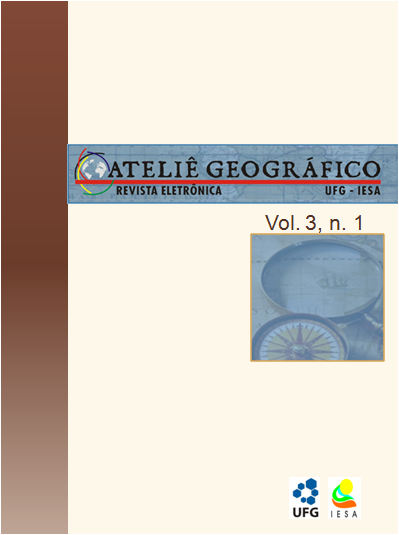THE TERRITORIAL SPACE AS REFERENCE FOR THE CONSTRUCTION OF THE CITIZENSHIP: AN INTRODUCTORY GEOGRAPHIC REFLECTION ON THE PROBLEM OF DEMARCATION OF “REMAINDERS” POPULATIONS LANDS
DOI:
https://doi.org/10.5216/ag.v3i1.6253Abstract
Territorially, the Brazilian history is loaded with conflicts and antagonisms. The modernization towards the cities and expansion of the internal market of consumption, national foundations of the new order, conflicts, not a few times, with interests of local collectivities. The deliberate design of the state to achieve new levels of production, with the expansion of production and flow in the territory, has not been accompanied by a similar policy of effective recognition of the different "nations" that formed the national population. More recently, the surface is the discussion on the "remainders", new creations of social emerge where new political subjects. The recognition of these multiple subject presents a reality in which differ widely among themselves. Regarding the territorial quilombola, is the clear differentiation of strong socio-stamp this area both with regard to the origins and ownership of the land, about the events of this (cultural, religious, located in the national territory, the type of housing and size of the community, use of resources, training and recognition in the fight, and so on.). Before this destruction, the rearrangement of productive activities and cultural, produces new relationships that can be considered hybrid. This hybridization, however, follows the logic, it seems, apart from the inclusion. Key-words: Territoriality; Quilombola; Hibridization; Remainders; CitizenshipDownloads
Download data is not yet available.
Downloads
Published
2009-05-14
How to Cite
ISOLDI, Isabel Araújo; SILVA, Clayton Luiz da. THE TERRITORIAL SPACE AS REFERENCE FOR THE CONSTRUCTION OF THE CITIZENSHIP: AN INTRODUCTORY GEOGRAPHIC REFLECTION ON THE PROBLEM OF DEMARCATION OF “REMAINDERS” POPULATIONS LANDS. Ateliê Geográfico Journal, Goiânia, v. 3, n. 1, p. 30–43, 2009. DOI: 10.5216/ag.v3i1.6253. Disponível em: https://revistas.ufg.br/atelie/article/view/6253. Acesso em: 27 dec. 2025.
Issue
Section
Articles
License
Autores que publicam nesta revista concordam com os seguintes termos:- Autores mantém os direitos autorais e concedem à revista o direito de primeira publicação, com o trabalho simultaneamente licenciado sob a Licença Creative Commons Attribution que permite o compartilhamento do trabalho com reconhecimento da autoria e publicação inicial nesta revista.
- Os autores não serão remunerados pela publicação de trabalhos na Revista Ateliê Geográfico. Além disso, os conteúdos publicados são de inteira e exclusiva responsabilidade de seus autores, ainda que reservado aos editores o direito de proceder a ajustes textuais e de adequação às normas da publicação.
- Autores têm permissão e são estimulados a divulgar seu trabalho online (ex.: em repositórios institucionais ou na sua página pessoal), já que isso pode gerar alterações produtivas, bem como aumentar o impacto e a citação do trabalho publicado (Veja O Efeito do Acesso Livre).


